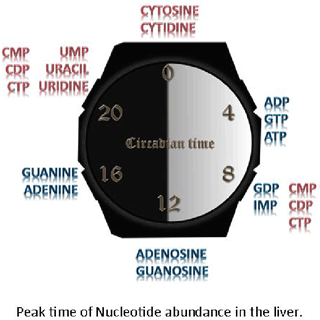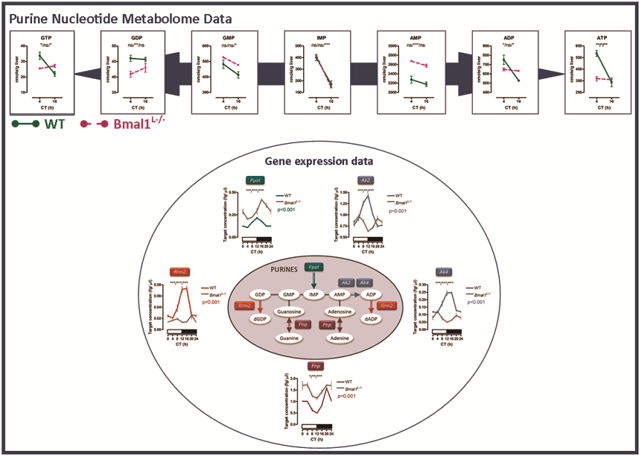April 17, 2012
A research group led by Jean-Michel Fustin and Hitoshi Okamura in the School of Pharmaceutical Sciences has demonstrated that the entire nucleotide metabolism is under the control of the circadian clock. From these results, it is speculated that new therapeutic agents that can control clock genes, when combined with conventional anti-cancer drug, constitute a novel anti-cancer therapy. This paper is published in Cell Reports at April 13, 2012.
Journal Paper Information
Rhythmic Nucleotide Synthesis in the Liver: Temporal Segregation of Metabolites
Fustin, Jean-Michel; Doi, Masao; Yamada, Hiroyuki; Komatsu, Rie; Shimba, Shigeki; Okamura, Hitoshi Cell Reports
doi:10.1016/j.celrep.2012.03.001
Outline
The authors have demonstrated that the entire nucleotide metabolism is under circadian control. Nucleotide metabolism is especially important in the liver, where both nucleotide anabolism and catabolism are being controlled in order to provide balanced nucleotide pools to the entire organism.
Daily variations of the abundance of some nucleotides in the liver and/or plasma in rodents have been previously reported, but a comprehensive analysis of the entire nucleotide metabolome, seeking to identify which steps are regulated by the circadian clock in the liver, and which steps are regulated at the systemic level, is lacking.
Here, using a combination of absolute quantification of gene expression by real-time PCR and the simultaneous quantification of nucleotides by state-of-the-art Capillary Electrophoresis Time-of-Flight Mass Spectrometry, they provide a circadian map of this fundamental pathway. The results show that rate-limiting genes involved in the synthesis and degradation of nucleotide in the liver are under transcriptional circadian control, mirrored in the rhythmic abundance of their products and substrates.
Interestingly, the authors found that when the circadian clock is disrupted in the liver, the concentration of ATP (the universal energy donor) becomes constantly low, suggesting energy deficiency. In contrast, the concentration of uric acid, the degradation product of purine nucleotides whose excess causes gout in humans, is constantly high, suggesting increased degradation of nucleotides. In addition, their results indicate that the synthesis of deoxynucleotides, which are necessary for DNA synthesis, may be deficient in clock-less animals.
In conclusion, their latest article provides an exhaustive analysis of the rhythmic nature of the fundamental nucleotide metabolism. Disruption of the hepatic clock leads to imbalances of nucleotides, which may have pathological consequences such as gout and impaired regeneration after operation in surgery.

Figure1:Peak time of nucleotide abundance in the liver.

Figure 2: Metabolic map of purines (center figure), and the circadian change of synthetic enzymes in wild type and liver-specific Bmal1-/- mice (surrounding figure). Upper figures show the change of purine nucleotides in wild type and liver-specific Bmal1-/- mice.

